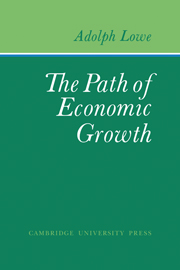Book contents
- Frontmatter
- Contents
- Preface
- Acknowledgments
- PART I The Basic Model
- 1 Introduction: Scope and Method
- 2 Patterns of Economic Growth
- 3 A Schema of Industrial Production
- 4 The Circulation of Fixed Capital
- 5 The Circulation of Working Capital
- 6 The Stationary Process in Operation: Structure Analysis
- 7 The Stationary Process in Operation: Force Analysis
- 8 Transition to Dynamic Equilibrium
- 9 Dynamic Equilibrium: Structure Analysis
- 10 Dynamic Equilibrium: Force Analysis
- PART II Changes in the Rate of Change
- PART III Changes in the Rate of Change
- PART IV Changes in the Rate of Change
- Appendix: An Alternative Presentation of Lowe's Basic Model
- Glossary of Recurring Symbols
- Name Index
- Subject Index
8 - Transition to Dynamic Equilibrium
Published online by Cambridge University Press: 07 October 2011
- Frontmatter
- Contents
- Preface
- Acknowledgments
- PART I The Basic Model
- 1 Introduction: Scope and Method
- 2 Patterns of Economic Growth
- 3 A Schema of Industrial Production
- 4 The Circulation of Fixed Capital
- 5 The Circulation of Working Capital
- 6 The Stationary Process in Operation: Structure Analysis
- 7 The Stationary Process in Operation: Force Analysis
- 8 Transition to Dynamic Equilibrium
- 9 Dynamic Equilibrium: Structure Analysis
- 10 Dynamic Equilibrium: Force Analysis
- PART II Changes in the Rate of Change
- PART III Changes in the Rate of Change
- PART IV Changes in the Rate of Change
- Appendix: An Alternative Presentation of Lowe's Basic Model
- Glossary of Recurring Symbols
- Name Index
- Subject Index
Summary
We are ready for the next step, the transformation of our stationary model into a model of dynamic equilibrium or steady growth. As we said earlier, dynamic equilibrium is to serve us as the frame of reference for our study of particular growth processes. However, because it is itself a phenomenon of growth, rather than stipulate dynamic equilibrium as a datum, we shall derive it from a state having no characteristics of growth. Our model of stationary equilibrium fulfills this function perfectly because, although displaying a zero growth rate, it shares with dynamic equilibrium essential properties such as continuous, full, and most efficient utilization of resources. By simply substituting for a constant flow of resources so utilized, a steadily changing (increasing or decreasing) flow, the dimension of growth is introduced. For the time being we shall confine ourselves to studying steady growth in the narrower sense of the term, namely, the effects on the system of an increase in resource supply. The quite asymmetrical effects of a decrease will be taken up separately.
Provisionally our concept of dynamic equilibrium coincides with that of the “golden age” in Mrs. Robinson's terminology. It presupposes that productive capacity rises through time in proportion to the rate of increase in labor supply plus the rate of capital-requiring increase in productivity. A further condition is the ‘neutrality’ of technical improvements, that is, only such improvements are admissible which, at a constant rate of profit or interest, do not alter either the capital–output ratios or the rates of depreciation in any one of the sectors.
- Type
- Chapter
- Information
- The Path of Economic Growth , pp. 70 - 76Publisher: Cambridge University PressPrint publication year: 1976



